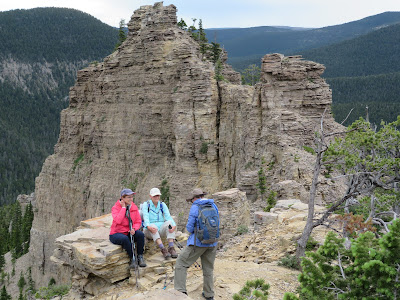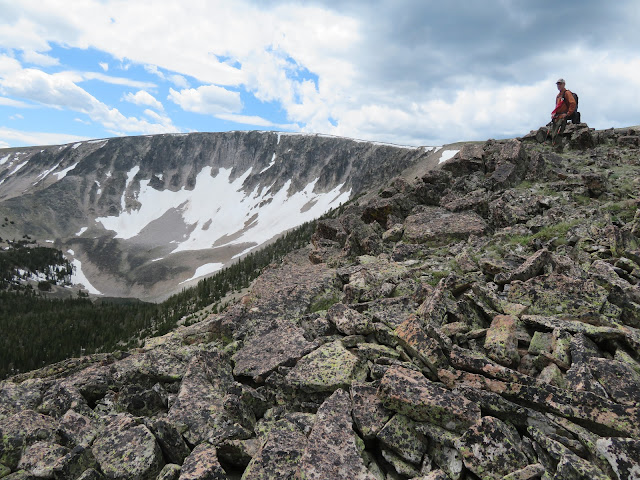 |
| Heart Lake with Red Mountain in background |
 |
| Enjoying the red at top of Red Mountains (and the views, too) |
 |
| The obligatory 'entering the wilderness' sign |
 |
| The Ranger Station at Webb Lake |
 |
| Katie celebrating at top of Red Mountain |
 |
| Katie pauses on the trail |
It was 50 years ago that Congress added the Scapegoat to the National Wilderness System, significant because it resulted from a citizen-led group that had opposed Forest Service plans to log, road and otherwise develop the area near Lincoln.
Here is a link about that fight for preservation of this 225,000 acres area south of the Bob Marshall Wilderness along the Continental Divide: https://books.google.de/books?id=FJ5voW8EAcoC&lpg=PA27&dq=quote%2C%20cecil%20garland&pg=PA27#v=onepage&q=quote,%20cecil%20garland&f=false
To celebrate this anniversary Katie and I did a three-day backpack trip from Indian Meadows to a camp between Heart and Webb lakes and climbed Red Mountain, at 9,411 feet the highest point in the Scapegoat, and the Bob Marshall Complex of wilderness areas.
It was particularly significant to me because my bosses at the Great Falls Tribune had sent me into this particular part of the Scapegoat 48 years ago to familiarize our readers with this new wilderness area.
Since that original trip I've returned to the Scapegoat numerous times and climbed Red Mountain many times but from different approaches than the one we used in 1974.
Time can play tricks on your mind after so many years. I don't remember much about that original climb. The route to Red Mountain is on FS Trail 223, which I gather was constructed for and used by packers supplying a lookout post on the mountain, long since removed. The Forest Service has done a nice job keeping the trail clear, but in spots it is a trace, particularly below the summit cap.
When we got to that cap, almost on cue about nine mountain goats appeared. On other occasions I've seen as many as 19 goats in this spot.
The wildflowers on the way up were glorious, particularly the purple silky phacelia that carpeted the path.
While a bit hazy from fires to the south, the views from the top were exceptional and it was fun to pick out the mountains of the Rocky Mountain Front from behind --- like Sawtooth and Steamboat. Scapegoat peak was particularly prominent, and of course there were the Swans, Silvertip and Great Northern to the west and north.
We stayed at a hunters camp and in the middle of the first night were awakened by critters that chewed holes in our tent's netting, which I had to patch when we got home.
That first day we took a side trip to Webb Lake after supper. There's a Forest Service cabin there. Red Mountain was visible from the lake's shore trail. It would have been a nice place to camp.
We walked out the third day via Heart Lake, an absolute gem with turquoise, deep water. There was only one camp there, and a fisherman said he had caught a grayling on a spinner there.
In retrospect, I wish we had camped there a night. There's always next time.
At about 5 a.m. on the day of our departure, Katie heard a bell clanking on the trail above our camp and we noted that at least one horse had come by. Just as we were ready to depart three hours later a young man on a horse was going quickly up the trail in pursuit of horses that had escaped a camp 8 miles above us, or 14 miles from the trailhead.
As we got near the trailhead that man had two horses stringing behind him and told us that he had to return to the Meadow Creek camp, break it down and come back out that day. That would be 42 miles of riding in one day!
The only other people we saw during that three days were several day trippers on horseback, and hikers coming out of the Landers Fork area. The horses have beat up the trails pretty badly.
This part of the Scapegoat was pretty empty, thank goodness.
Because I didn't remember a lot about my trip years ago, this area was a fresh experience.
There will be a 50th anniversary celebration in Lincoln Sept. 16-17.






















